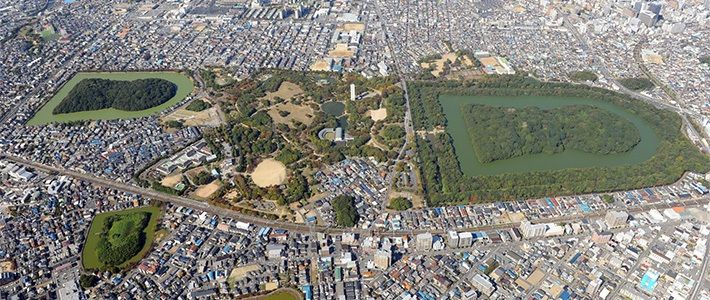
Japan Burial Site Under Excavation One of World’s Largest
Culture- English
- 日本語
- 简体字
- 繁體字
- Français
- Español
- العربية
- Русский
In late October 2018, excavation work began on Daisen Kofun, Japan’s largest burial mound, managed by the Imperial Household Agency as the tomb of Emperor Nintoku. The country’s kofun burial mounds were built to house the tombs of leaders from the third to the seventh century by heaping up earth and stones to fashion hill-like shapes. There are some 200,000 around Japan.
Daisen Kofun is in Sakai, Osaka Prefecture. According to the city’s official website, the burial mound is 486 meters long and 35.8 meters tall (at its highest point). If the three moats that enclose the burial mound are also included, the total length stretches to 840 meters. Although not as big as the Great Pyramid of Giza in Egypt or the Mausoleum of the First Qin Emperor in China, it is one of the largest burial sites in the world.
| Length (m) | Height (m) | Volume (m3) | |
|---|---|---|---|
| Daisen Kofun | 486 | 35.8 | 1.4 million |
| Great Pyramid of Giza | 230 | 146 | 2.6 million |
| Mausoleum of the First Qin Emperor | 350 | 76 | 3 million |
Created by Nippon.com based on information from the official website of Sakai, Osaka Prefecture.
The mound resembles a keyhole in shape, combining curved and straight lines. The interior of Daisen Kofun is not open to the public, but there is a 2.8-kilometer path for visitors to walk the circumference and view the site from up close. Given the vast size of the burial mound, however, one cannot see the whole site from a close proximity. The website of the Sakai Tourism and Convention Bureau recommends the following three locations from which to view Daisen Kofun in its entirety: the overpass on the south side of the nearby Nagayama Kofun, the overpass on the south side of Mozu Station on the JR Hanwa Line, and the twenty-first floor observatory of the Sakai City Hall.
The Japanese government has submitted a bid to UNESCO for the Mozu-Furuichi Kofungun, group of ancient burial mounds, including Daisen Kofun, to be registered as World Heritage sites. The IHA began its October excavation work in three archeological trenches with the cooperation of the Sakai city government as part of the effort to compile basic materials on preservation of the burial mounds.
Access: A five-minute walk from Mozu Station on the JR Hanwa Line.
(Translated from Japanese. Banner photo: Daisen Kofun [right side] and the adjacent burial tombs © Pixta.)
Osaka World Heritage emperor Kansai Sakai history kofun Daisen Kofun